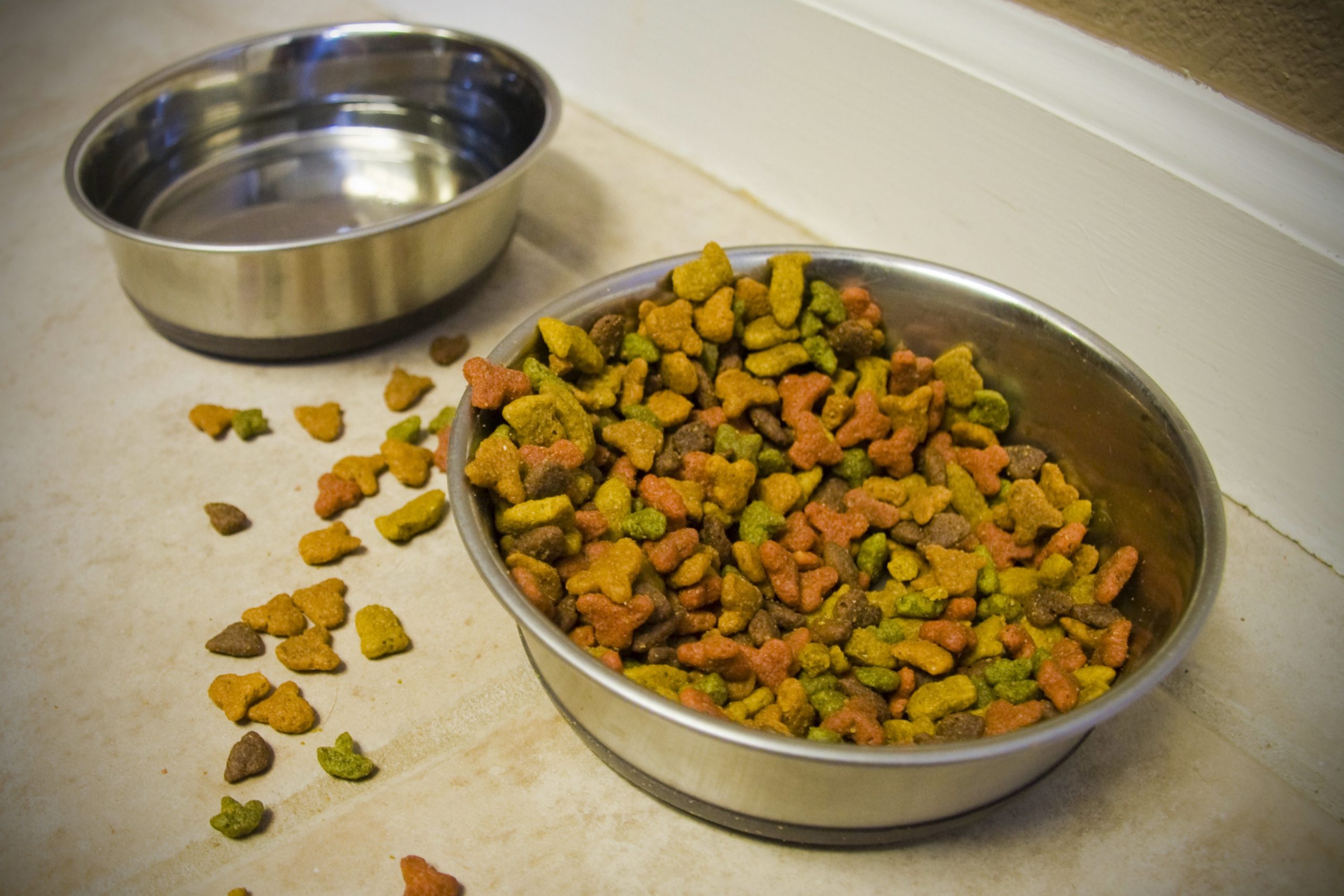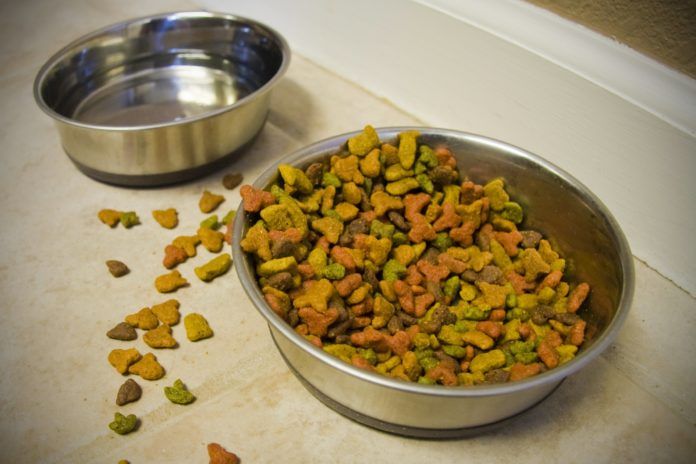Feline nutrition is a fine balancing act when a cat requires a special diet for a serious health condition like kidney disease. While a kidney disease diet is not a cure, it is a way to help manage the disease in order to minimize symptoms, improve quality of life and hopefully prolong the cat’s lifespan. To better understand a kidney disease diet and how it works, first it’s important to understand the nature of kidney disease.
Every day, the body produces metabolic waste products that must be removed from the body to prevent toxin build-up in the bloodstream. Most of these normal wastes in the blood are circulated to the kidneys where they are filtered out of the bloodstream into the urine and excreted. A healthy kidney makes highly concentrated urine containing large amounts of waste that is eliminated in a small amount of urine.
A diseased kidney is no longer able to make concentrated urine, which means that it requires more water to remove the same amount of waste. A common sign of kidney disease is the consumption of more water and production of copious amounts of urine. Ultimately, the cat simply cannot drink enough water and the waste levels increase in the body.
Kidney disease is progressive and can be identified by four stages. The International Renal Interest Society (IRIS) has developed the numbered stages ranging from least severe to most severe: Stage 1 Pre-Failure, Stage 2 Mild Failure, Stage 3 Moderate Failure and Stage 4 Severe Failure.
A diagnosis of kidney disease is most commonly based on signs, physical examination and blood and urine tests.
Protein Levels in Kidney Disease Cat Food
No one specific kidney diet fits all stages of kidney disease, or every cat. And the topic of how much protein to feed cats with kidney disease is still controversial among experts. “In the past, when a cat was initially diagnosed with kidney disease, there were fewer diet options and a practitioner might jump to the lowest protein diet available. Today’s trend is not to be as aggressive with low protein diets with cats in the early stages, Stage 1 or Stage 2,” explains Cailin Heinze, VMD, MS, DACVN, assistant professor of nutrition at the Cummings School.
According to Dr. Heinze, there is currently no data supporting a benefit of low protein diets for cats in the earliest stages. The flip side is that there is also not a lot of data that suggests that feeding a higher protein diet — as some experts have more recently recommended — is beneficial for cats in the earliest stages of disease. As the kidney worsens, and the blood values (blood urea nitrogen and creatinine) start to climb, however, lower protein diets can help keep these values as low as possible and help the cat to feel better.
“The kidney is responsible for removing excess nitrogen from the system, among other things. The majority of nitrogen comes from protein in the diet, so if you have a very low protein diet, it is absolutely critical that the protein be very, very high quality. In order to have the least amount of protein possible, the protein has to be highly digestible and have the right amount of ratios of amino acids. In this way, you can minimize the extra nitrogen and give the cat only the amount of needed protein,” says Dr. Heinze.
Phosphorous in Cat Food for Kidney Disease
According to Dr. Heinze, the bigger complication is the inter-relationship between phosphorous and protein. Phosphorous is a component of muscle and organ meat, which are the main protein sources found in most feline diets.
“Phosphorous is the only independent nutrient definitively associated with the progression of kidney disease,” explains Dr. Heinze. “In cats, we have studies that suggest the combination diets (“kidney diets”) that have modifications in protein, phosphorous, the acidification of the diet and a number of other factors double the lifespan of cats with kidney disease. We think a lot of the benefits of these diets is due to the low phosphorus levels, and so we make it a priority to keep blood phosphorus in the low-normal range with the help of diet.”
According to Dr. Heinze, most regular cat diets — dry or canned — range from about 2 to 5 grams of phosphorous per 1,000 calories, with the average of 3 grams. She said very few of regular diets are less than 2 grams. Kidney diets, on the other hand, range from about 0.6 grams to about 1.25 grams of phosphorous per 1,000 calories. That’s a tremendous difference in diets.
The Perfect Kidney Diet for Cats?
Ideally, these cats would eat a canned kidney diet. However, some cats simply don’t like canned food. And if the owner didn’t feed the cat canned food before the development of the kidney disease, the chances of that cat eating canned after being diagnosed with kidney disease is next to nil, according to Dr. Heinze.
THINKSTOCK

“I would always prefer a cat with Stage 3 or Stage 4, and some Stage 2 — depending on how high the cat’s levels are and what stage they’re in — to eat a canned kidney diet, or at least a diet that is lower in phosphorous and protein. However, I would rather a cat with kidney disease eat a dry renal diet than a canned non-renal diet. A lot of the regular canned diets tend to be higher in phosphorous, sodium and higher in protein than dry diets. You can create more problems for a cat by feeding a diet with inappropriate nutrient levels than are likely to be made up for by the moisture in the canned food,” says Dr. Heinze.
“So, in a perfect world, they’re going to eat a canned kidney diet, second best choice is a dry kidney diet, and third best choice, well, at that point, we’re at a ‘compromise diet.’ Do the least amount of harm possible whether it is canned or dry,” says Dr. Heinze.
Supplementing Your Cat’s Kidney Diet
Supplements — which include antioxidants, omega-3 fatty acids and B-vitamins — can be added to the diet to help optimize health. Regarding the use of antioxidants, Dr. Heinze says that there is not enough data on the use of antioxidants in cats with kidney disease and that, generally, the antioxidant data across the board is weak for many diseases. She feels that while they make sense theoretically, some studies in humans have discovered that the use of antioxidants can make some diseases worse.
Conversely, there is data suggesting the use of omega-3 fatty acids can be beneficial for kidney disease in various species, including some data in cats, says Dr. Heinze. She says the challenge is that the ideal dose of omega-3s for cats and dogs is unknown. “Omega-3s may be helpful, but for cats specifically, omega-3s should come from fish oil, never from flax. The omega-3s that have been studied in terms of kidney effects have been the long-chain EPA and DHA, and cats don’t convert the short-chain omega-3 fatty acids that are found in flax or other plants to DHA and EPA,” says Dr. Heinze.
According to Dr. Heinze, most — if not all — kidney diets are supplemented with additional B-vitamins in higher levels than the average maintenance diet. Currently, there is minimal data regarding B-vitamin supplementation and cats with kidney disease. Because the kidney diet is typically already supplemented with extra B-vitamins, Dr. Heinze questions the need to add extra supplements on top of what’s already in the diet.
Water Intake for Cats with Kidney Disease
Generally, the more water a cat with kidney disease drinks, the better. Not all cats are “good drinkers” — and that’s where the canned kidney diet helps because a canned diet has a high water content and therefore increases the daily water intake. There are a few options to try with cats to increase water intake, including adding water or broth to dry food. The concern regarding commercially prepared broths is the unknown amounts of onion and garlic, and the typically high amounts of sodium. You can always make your own broth — omitting the offenders — and freeze it for later use. Dr. Heinze says, “Sodium is one of the nutrients we worry about in kidney disease, even though the data isn’t as strong as for phosphorus.”
Other suggestions for increasing water intake include moving the water dish away from the food, supplying additional water dishes throughout the home and the use of drinking fountains for those cats that enjoy them. Dr Heinze says some cats in later stages require subcutaneous (under the skin) fluids given at the vet clinic or in the home.
Stage of Disease Matters When Finding a Kidney Diet
When feeding a cat with kidney disease, it’s crucial to understand the condition of the kidneys, and which stage of the disease the cat is in. Choosing the most suitable kidney diet can help to manage this incurable, progressive disease by providing optimal health, reducing symptoms and increasing longevity. Using evidence-based information, your veterinarian can make the best recommendation for a kidney diet for your individual cat’s needs.





I very much enjoyed your article. Lots of good info here. My question is how much do I feed my stage 3 kitty. He really enjoys his prescription kidney food. I try to feed him small amounts throughout the day. I estimate that he is eating 10 oz of food a day ( 2 cans) Would this be the correct amount. I do not want to tax his kidneys with too much food. He is currently 10lbs at 16yrs old. Thank you, Tess